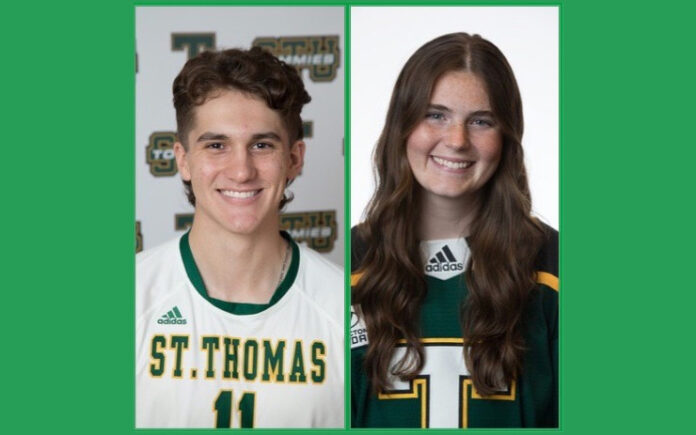

For university student-athletes, the bus trip to away games is no foreign concept. Ranging from short, one-hour rides to Saint John, or long treks to Antigonish, N.S., Mason Brewster and Natalie MacKay are familiar with them all.
In his second year on the men’s volleyball team, Brewster had traveled with his high school volleyball team before, but on shorter trips near his hometown of Bathurst. Now, his longest trip with STU is almost eight hours to Church Point, N.S., to take on the Université Sainte-Anne Dragons.
He finds the bus trips to be “the perfect time” to get homework done. He’ll split his time doing work, then taking breaks and chatting with teammates. Some bring gaming consoles, like a Nintendo Switch, while others will play group games on their phones.
“Usually the guys are really excited the whole way,” said Brewster. “I think this is definitely a team that’s been the most loud on the bus, which I love.”
Though being over six feet tall makes sleeping difficult, he’s found the perfect position of leaning against the window and putting his legs on the headrest of the seat across the aisle.
“If someone has to go to the bathroom, they’ll have to climb over us or go under our legs,” he said.
One of his favourite memories traveling with the team is when they didn’t have access to a bus and were taking the subway around Montréal during a preseason trip.
“[Head coach] Henri was running towards the bus stop … it was a connecting bus and we still had guys on the escalator, so he was telling us ‘Run! Run! Run!’,” said Brewster. “[Austin Hamilton] got in and his bag got stuck, so we had to rip the door open so we could get his bag out.”
Traveling to away games can change the pregame routine, but Brewster tries not to overthink.
“There’s a lot of pressure when it comes to if it’s an important game,” he said. “I try to take 45 minutes just to listen to music and lock in.”
Getting on the bus for a long trip back is tough after a loss, said Brewster, though energy picks up again as the team stops for food and processes the game.
“If we won, I love being on the bus. It’s the best thing ever, I’d rather be on the bus than just go home,” he said. “If we lost … the energy’s down and everyone’s quiet.”
Natalie MacKay of the STU women’s hockey team feels differently, saying the trip after a tough game can help her team.
“We’re able to kind of cope with the loss together and not make light of the situation, but reflect on what happened and then move on very quickly,” she said.
While after home games players may leave quickly after post-game speeches and cool down, she feels that on the bus, the team is able to process the loss together.
“When you’re on the bus, you’re able to talk to people and reassure that we’re still a team and that we’re all still together and a family,” said MacKay. “We still love and appreciate each other.”
MacKay is known amongst her teammates for getting studying done on the bus, while many others struggle due to car sickness or boredom. She puts her laptop on her legs, leans against the back window and it’s time to “get to work.”
“I find I get a lot of work done on the bus actually, because I don’t often give myself other things to do,” said MacKay. “If I do give myself other things to do, I get bored of them very easily.”
While some may fuss over pillows or blankets, Mackay’s bus essential is a sleep mask.
“I will forever bring an eye mask,” she said. “The windows in there are very bright and the sun shines through very clearly.”
The forward from Truro, N.S. had limited team travel before coming to STU, but one of her standout memories was traveling to WickFest in Calgary.
“It was really cool traveling to another province on a plane as a young girl in female sport and getting to see Hayley Wickenheiser,” said MacKay. “I will never forget that memory.”
